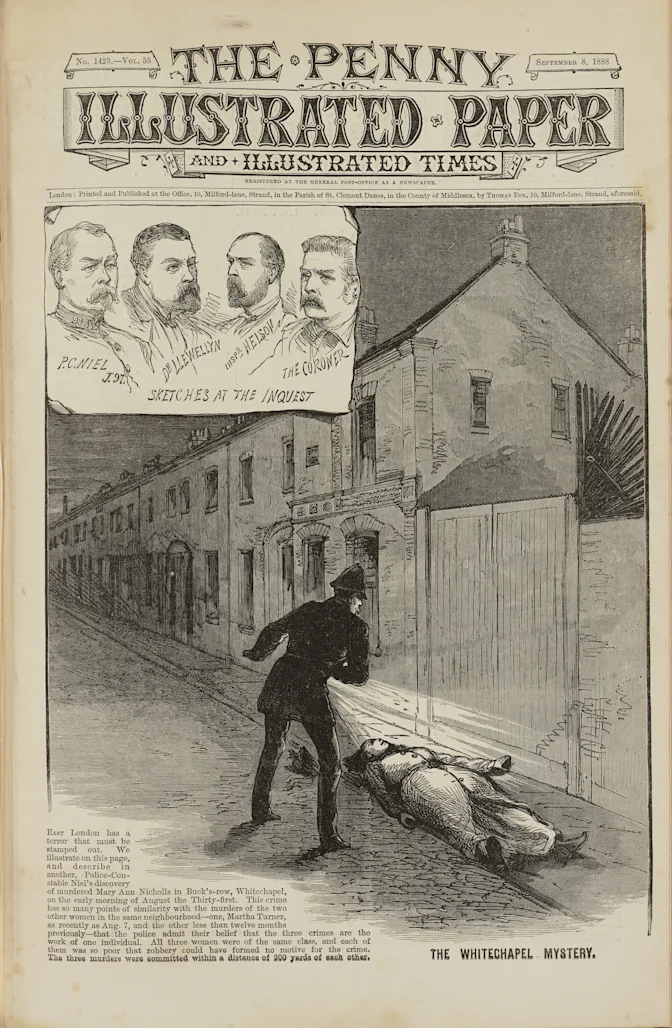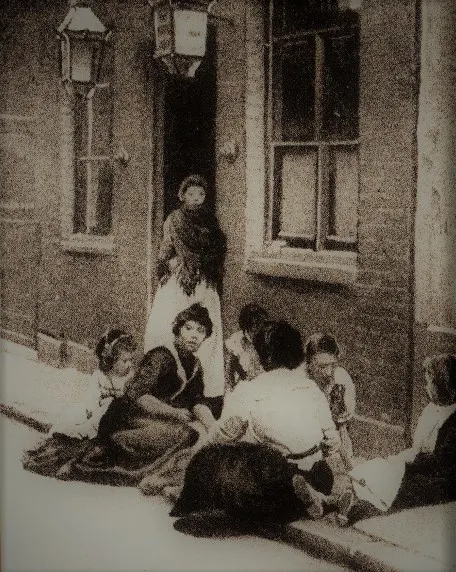
Jack the Ripper's Bloody Legacy
London, 1888. Amid the fog-shrouded streets of Whitechapel, a dark figure lurked. The city was gripped by fear, and the press couldn't stop speculating: Who was the faceless figure committing gruesome murders against the most vulnerable women in society? The mystery of Jack the Ripper remains one of the most chilling unsolved cases in history. Yet, more than 130 years later, fascination with the story continues. Here, we dive deep into the haunting tale of Jack the Ripper, the notorious figure who both terrorized and fascinated the Victorian world.
 The Penny Illustrated Paper - September 8, 1888. Public domain.
The Penny Illustrated Paper - September 8, 1888. Public domain.
The Backdrop: Whitechapel, London's Dark Side
In the late 19th century, London was the thriving heart of the British Empire, symbolizing industrial prosperity and global power. But beyond the grand facades of the West End, a world of squalor and hardship loomed in the East End's Whitechapel district. Life in Whitechapel was bleak — streets teemed with disease, poverty, and alcoholism. Many women were forced into prostitution to survive, a grim reality that made them vulnerable to violence and exploitation.
For five women — Mary Ann Nichols, Annie Chapman, Elizabeth Stride, Catherine Eddowes, and Mary Jane Kelly — survival in Whitechapel ended in tragedy. Between August and November 1888, each of these women was found brutally murdered, their bodies defiled in a way that shocked even seasoned police officers. Their killer, soon dubbed "Jack the Ripper," became infamous for his cold precision and apparent disdain for the lives he took. Though the cases remain unsolved, the details reveal a chilling look at the underside of Victorian London.
The Murders: Victims Caught in the Shadows
The series of murders began on Aug. 31, 1888, when the body of Mary Ann Nichols, a 43-year-old mother, was discovered. Nichols had been abandoned by her husband and left to survive through odd jobs and sex work. Less than a week later, Annie Chapman's body was found in a yard on Hanbury Street. Her throat had been slit, and her abdomen cut open with such force and precision that police suspected a knowledge of anatomy, though this was later disputed.
A month later, the killer escalated. On Sept. 30, two more women were murdered in a single night. Elizabeth Stride was killed, though her body had fewer injuries, possibly indicating the Ripper had been interrupted. Shortly after, Catherine Eddowes was discovered, her body was viciously mutilated.
The final known victim, Mary Jane Kelly, was found on Nov. 9, 1888, in her small, rented room. Her body was so horrifically defiled that it disturbed even the hardened investigators on the scene. Kelly's murder concluded what would become known as the "Autumn of Terror," a period when women in Whitechapel walked the streets with constant fear, knowing a predator lurked among them.
 Poverty in the East End, circa 1890. Author unknown. Public domain.
Poverty in the East End, circa 1890. Author unknown. Public domain.
The Investigation: A Desperate Search
London's Metropolitan Police, under the scrutiny of the public and press, scrambled for leads. Detective Edmund Reid noted that each victim was connected by their poverty and profession, but beyond this, the investigation had few promising leads. Witnesses were unreliable, and any physical evidence was scant. The lack of witnesses, paired with the ease with which the Ripper escaped, suggested the killer's intimate knowledge of Whitechapel's winding alleys.
While the police were at a loss, the press fueled a frenzy, publishing gruesome details and suggesting theories that sensationalized the murders. The press received a letter on Sept. 27, claiming to be from the killer, signed "Jack the Ripper." Whether real or a hoax, this letter spurred a wave of paranoia. The police and newspapers received hundreds of additional letters, many likely pranks, though a few seemed chillingly authentic.
Theories and Suspects: Who Was Jack the Ripper?
The Ripper's profile has evolved, spawning a field called "Ripperology." Various suspects have been proposed over the years, each new theory capturing the public imagination. Early suspects included working-class men such as Aaron Kosminski, a Polish immigrant with a history of mental health struggles, and John "Jack" Pizer, a shoemaker. Both men had ties to Whitechapel, but neither was definitively connected to the crimes.
In the early 1900s, police also considered Francis Tumblety, an eccentric American doctor who was in London during the murders. Though he was suspected, there was little concrete evidence tying him to the Ripper's atrocities. In recent years, DNA evidence has reignited debate. A 2014 analysis of a shawl said to belong to victim Catherine Eddowes identified DNA similar to Kosminski's, but questions about contamination cast doubt on these results.
Some theorists believe the Ripper was a surgeon or physician due to his precise incisions. However, this has been contested. Dr. Thomas Bond, who examined the bodies, argued that the killer showed a desire for brutality rather than medical expertise, suggesting a profound disregard for human life rather than surgical skill.
His Victims: Whitechapel's Vulnerable Women
Though the Ripper is often the center of attention, the women he murdered remind us of the hardships faced by impoverished women in Victorian England. The confirmed victims of the killer known as Jack the Ripper were mothers, daughters, and workers who lived difficult lives shaped by poverty, limited opportunities, and social prejudice. Their deaths forced middle- and upper-class Victorians to acknowledge the existence of those they typically ignored — the poor, the vulnerable, and the forgotten of Whitechapel.
The murders sparked public debate on social reform. Queen Victoria herself pressured officials to address Whitechapel's appalling living conditions, though progress was slow. George Bernard Shaw, a playwright and social critic, commented wryly that the murders brought more attention to social injustice than years of political advocacy.
The Legacy of the Ripper: A Legend That Won't Die
The fascination with Jack the Ripper continues today, with numerous books, films, and even "Ripper tours" dedicated to exploring the case. The mystery surrounding his identity remains, making him an enduring figure in the history of crime. Psychologists and historians continue to debate the Ripper's motives, and the questions surrounding his identity persist in popular culture.
Many theories persist, including the notion that Jack the Ripper was a member of high society, possibly even royalty. Others argue that he was a foreigner or transient, adding an element of xenophobia to the mystery. While each theory offers tantalizing clues, the truth remains elusive.
A Dark Reflection of Victorian Society
In the end, the story of Jack the Ripper reveals more about Victorian society than it does about the killer himself. The panic surrounding his murders unveiled London's divisions, from class prejudice to the fear of a hidden criminal underclass. The case highlighted the vulnerability of Whitechapel's residents and the harsh realities of life in the city's poorest quarters.
The five women who perished remain iconic symbols of the darkness of the era in London's East End. As for Jack the Ripper, he continues to haunt the imaginations of those fascinated by the unsolved mystery, a dark figure who slips through history's grasp, his identity forever unknown.
References: Who Was Jack the Ripper? | Jack the Ripper























